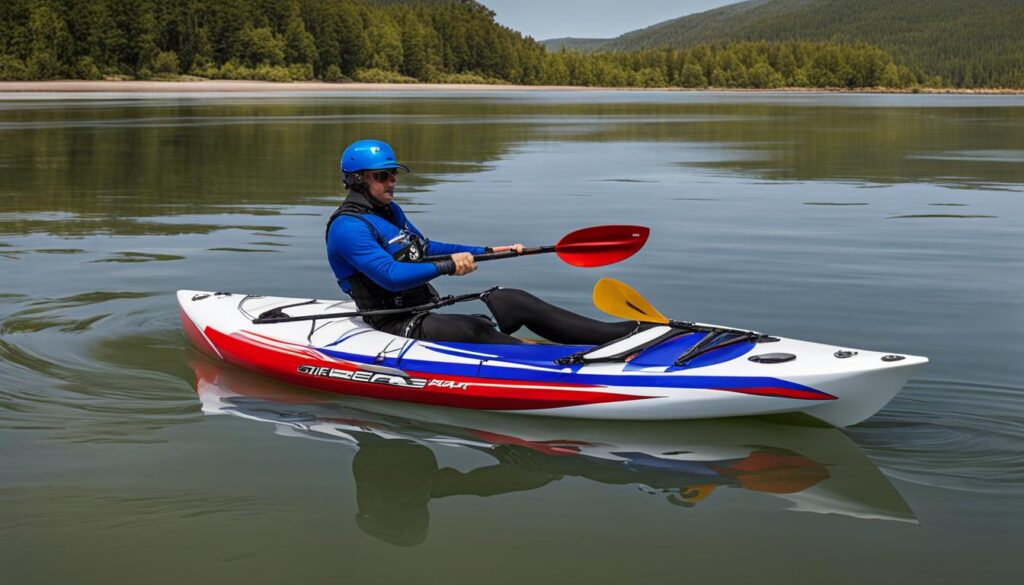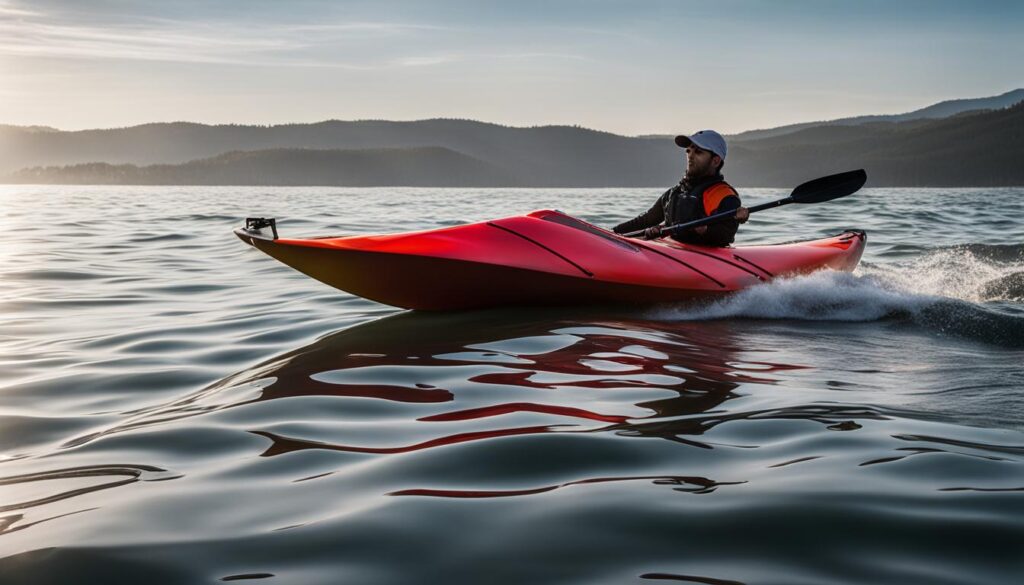Understanding the different aspects of kayak hull design is crucial for enhancing your paddling experience. The shape of the hull plays a significant role in determining the performance of a kayak. Whether you prioritize stability, speed, or maneuverability, customizing your kayak hull design can make a noticeable difference.
Key Takeaways:
- Choose between planing hulls and displacement hulls based on your desired performance characteristics.
- Consider the type of chines or rails on the kayak hull to achieve the desired level of stability and steering capabilities.
- Understand the impact of rocker on your kayak’s ability to ride over features and stay balanced.
- Volume levels vary in different types of kayaks, allowing you to choose a hull design suitable for your specific needs.
- Customize your kayak hull materials and construction to optimize performance and durability.
The Importance of Stability in Kayak Hull Design
When it comes to kayak hull design, stability is a crucial factor to consider. The way a kayak handles in the water and maintains balance can greatly impact your paddling experience. Understanding the principles of kayak hull efficiency and hydrodynamics can help you choose a kayak that offers the desired level of stability for your needs.
There are two main types of stability to consider when evaluating a kayak’s hull design: primary stability and secondary stability. Primary stability refers to a kayak’s ability to counteract leaning motions and maintain balance. Kayaks with high primary stability are initially stable but may feel less stable in rough water. On the other hand, secondary stability provides stability further into the lean, making them more suitable for challenging conditions.
The design and shape of the kayak hull, including whether it is flat, rounded, V-shaped, or pontoon, can affect stability. Additionally, factors such as the distribution of flotation and buoyancy within the hull, as well as the center of gravity and center of buoyancy, play a role in determining stability. By understanding these elements, you can make an informed decision when selecting a kayak hull that offers the stability you need.
Whether you’re an experienced paddler or just starting out, choosing a kayak with the right stability is essential for an enjoyable and safe paddling experience. By considering the principles of kayak hull efficiency and understanding how the design affects stability, you can find the perfect kayak that suits your needs and enhances your time on the water.
| Primary Stability | Secondary Stability |
|---|---|
| Initial stability | Stability into the lean |
| May feel less stable in rough water | More suitable for challenging conditions |
| Affected by hull shape and design | Dependent on distribution of flotation and buoyancy |
Impact of Hull Shape on Speed and Maneuverability
When it comes to kayaking, the shape of the hull plays a significant role in the performance of the kayak. The dynamics of the hull, including factors such as wetted surface area, shape, and rocker, directly impact the speed and maneuverability of the kayak. Innovations in kayak design have led to the development of streamlined hulls specifically engineered for racing kayaks, offering increased speed and efficiency on the water.
“The streamlined hull design revolutionized the world of racing kayaks. By reducing drag and optimizing hydrodynamic properties, these kayaks can achieve incredible speeds with minimal effort,” explains John Davis, a renowned kayak designer.
In addition to the overall shape of the hull, the length and width of the kayak also contribute to its performance. Longer kayaks tend to have higher top speeds but may sacrifice maneuverability, while shorter kayaks are more nimble but may not reach the same speeds. The presence of tracking channels and keel lines further enhances the kayak’s ability to maintain a straight course and maneuver efficiently.
Table: Comparison of Kayak Hull Shapes
| Flat Hull | Rounded Hull | V-Shaped Hull | Pontoon Hull | |
|---|---|---|---|---|
| Stability | Low initial stability, high secondary stability | Moderate initial stability, moderate secondary stability | High initial stability, low secondary stability | Extremely high initial stability, low secondary stability |
| Maneuverability | High maneuverability, easy to turn | Moderate maneuverability, balanced turning | Lower maneuverability, harder to turn | Low maneuverability, difficult to turn |
| Speed | Lower top speed due to increased drag | Improved speed compared to flat hull | High top speed, excellent glide | Lower top speed, increased stability |
By understanding the impact of hull shape on speed and maneuverability, paddlers can make informed decisions when choosing a kayak. Whether you’re aiming for record-breaking speeds or seeking agile maneuvering capabilities, selecting the right hull shape can enhance your overall kayaking experience.

Advanced Materials for Kayak Hull Construction
When it comes to kayak hull construction, advancements in materials have opened up new possibilities for enhancing performance on the water. While traditional materials like polyethylene and fiberglass are still widely used, there are now advanced options available that offer significant advantages in terms of weight, strength, and rigidity. These materials allow for customizing kayak hulls to optimize performance based on individual preferences and needs.
Carbon fiber is one of the most popular advanced materials used in kayak hull construction. It is known for its exceptional strength-to-weight ratio, making kayaks lighter and more maneuverable. Carbon fiber hulls can provide increased speed and responsiveness on the water, making them a favorite among competitive paddlers.
Another popular advanced material is Kevlar. Kevlar is a synthetic fiber that is renowned for its high tensile strength and resistance to impact. Kayaks built with Kevlar hulls are incredibly durable and can withstand the rigors of rough water conditions. They are also lightweight, which contributes to improved performance and easier handling.
| Material | Advantages |
|---|---|
| Carbon Fiber | Exceptional strength-to-weight ratio, increased speed and maneuverability |
| Kevlar | High tensile strength, resistance to impact, durability |
| Polyethylene | Affordability, durability, resistance to UV damage |
| Fiberglass | Lightweight, versatility, ease of repair |
Other advanced materials used in kayak hull construction include fiberglass and polyethylene. Fiberglass offers a combination of strength, versatility, and ease of repair, making it a popular choice for recreational kayaks. Polyethylene is known for its affordability, durability, and resistance to UV damage, making it suitable for kayakers looking for a cost-effective option without sacrificing performance.
By utilizing these advanced materials, paddlers can customize their kayak hulls to achieve the desired characteristics for their paddling style and preferences. Whether it’s speed, maneuverability, durability, or a combination of factors, the choice of materials plays a crucial role in optimizing performance on the water.

Customizing Kayak Hulls for Performance
Alongside the use of advanced materials, customizing kayak hulls can further enhance performance on the water. By making modifications and adjustments to the hull design, paddlers can tailor their kayaks to their specific needs and preferences.
One common customization is altering the hull shape. Different hull shapes offer varying advantages, such as increased speed, stability, or maneuverability. By selecting a hull shape that aligns with their intended use, paddlers can enhance their overall performance and enjoyment.
Another customization option is adding reinforcement layers to the hull. This can provide increased durability and impact resistance, making the kayak more resilient in rough water conditions. Reinforcements can be strategically placed in areas prone to wear and tear, ensuring the kayak withstands the demands of intense paddling.
Additionally, integrating features like skegs and drop-down skegs can improve tracking and stability. These additions help maintain a straight course in windy conditions or challenging currents, allowing paddlers to focus on their strokes rather than constantly correcting their kayak’s direction.
In conclusion, advanced materials and customization options have revolutionized kayak hull construction. Paddlers now have the ability to choose from a range of materials that offer superior performance characteristics. By customizing their kayak hulls to suit their individual needs, paddlers can enhance their paddling experience and achieve optimal performance on the water.
Choosing the Right Kayak Hull for Your Needs
When it comes to selecting a kayak hull, finding the right design for your specific needs is crucial. If you’re an ocean kayaker, you’ll want a hull that excels in rough water conditions and can handle waves and currents effectively. Stability becomes a top priority to keep you steady and confident on the water.
Customizing your kayak hull can further enhance its performance. Consider adding skegs or drop-down skegs to improve tracking, allowing you to maintain a straight course even in challenging conditions. These modifications can make a significant difference in your overall paddling experience.
It’s also essential to think about the physical characteristics of your kayak. The length, width, and volume of the hull should match your body size, skill level, and intended use. Finding the right balance between speed, stability, and maneuverability will ensure you have a kayak that suits your preferences and delivers the performance you desire.
So, whether you’re exploring the open ocean or gliding along serene lakes, choosing the right kayak hull design will make all the difference. Take the time to consider your specific needs, customize where necessary, and get ready to embark on unforgettable paddling adventures.
FAQ
What role does hull shape play in kayak performance?
The hull shape determines the kayak’s performance. Planing hulls offer maneuverability but increase drag, while displacement hulls provide speed in the forward direction.
How do chines or rails affect kayak stability?
Hard chines offer better steering, while soft chines provide increased stability.
What is the impact of rocker on kayak performance?
Rocker affects how well the kayak rides over features and its ability to stay flat in the water.
How does volume differ in different types of kayaks?
Freestyle kayaks have lower volume for agility, creek boats have high volume to stay above water, and crossover kayaks combine stability with touring capabilities.
What is the difference between primary and secondary stability?
Primary stability refers to initial balance, while secondary stability provides stability further into the lean and is essential for rough water conditions.
How do hull dynamics impact kayak performance?
Factors such as wetted hull surface area, shape, and rocker influence speed and maneuverability.
What materials are used for kayak hull construction?
Traditional materials include polyethylene and fiberglass, while advanced materials like carbon fiber and Kevlar offer advantages in weight, strength, and rigidity.
How can I customize a kayak hull for better performance?
Customizations can include adding reinforcement layers or altering the layup of materials to achieve desired characteristics.
What hull design is suitable for ocean kayaking?
A hull design that provides stability in rough water and can handle waves and currents effectively is crucial for ocean kayaking.
How should I choose a kayak hull based on my needs?
Consider factors such as length, width, and volume based on your size, skill level, and intended use. Decide whether you prioritize speed, stability, or maneuverability.





